|
2016 Riding Season for the Delta-11 Prototype |
|
Summary Here's a picture of the Delta-11 Prototype Electric Motorcycle on it's last ride of the 2016 riding season. This picture was taken in the Taco Bell parking lot. The owner of the hybrid parked next to the bike stopped me and said we had talked earlier in the summer and wondered if I had taken the bike on the camping trip to the Upper Penisula I had talked with him about. I mentioned I was planning to take the body work off and make new body work that was good looking and both he and his wife said no, they thought the current body work was very good looking. It was a windy day, I rode with the large empty storage box on back and was tossed around much more by the wind than I had been for the entire riding season. The lightweight, empty box on back was much worse for cross wind stability than the smaller box I normally carry that has 100# of battery's in it. The bike was responding correctly to the wind, but was much more affected. 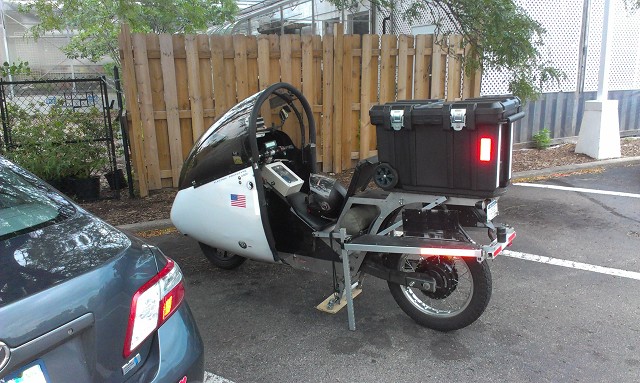 Here is picture of bike in it's most common configuration for the 2016 Riding Season. The extra battery pack on the back with a collapsable duffle bag on top and my matched set of black laptop bags, one on each side, normally one filled with my workout clothes, the other with my business paperwork.  Here is a typical stop at the grocery store, showing how the collasable bag holds about three bags of groceries. On long trips the collapseable bag would be filled with extra chargers and charging gear. 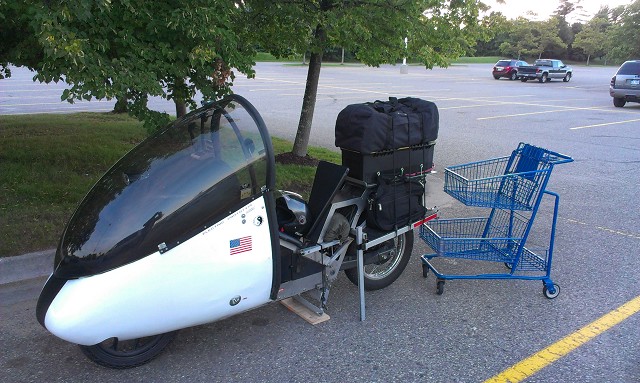 Here's a picture of the Odometer after completing the last ride of the season. 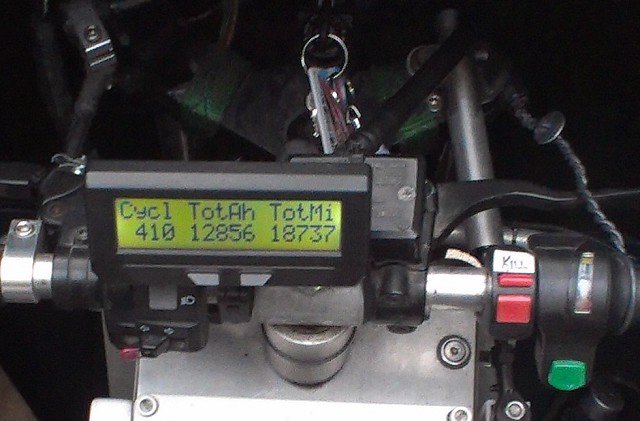 Number of Rides: 52 Total Miles Ridden: 2,523 Miles Average Miles Per Ride: 37 Miles 2016 Riding Season: June 23, 2016 - September 27, 2016 Energy Consumed: 263 kW Hours Cost of Energy @ $.17/ kWh = $44.71 Energy Cost per Mile: $.018 Efficiency: 105 Wh/Mile from the Wall (based on 77% recharge Efficiency) 322MPGe Total Miles to date on bike: 18,737 Miles Lifetime Fuel Economy: 350 MPGe See Entire history on Ecomodder at this link; Ecomodder History Charts showing the season data: 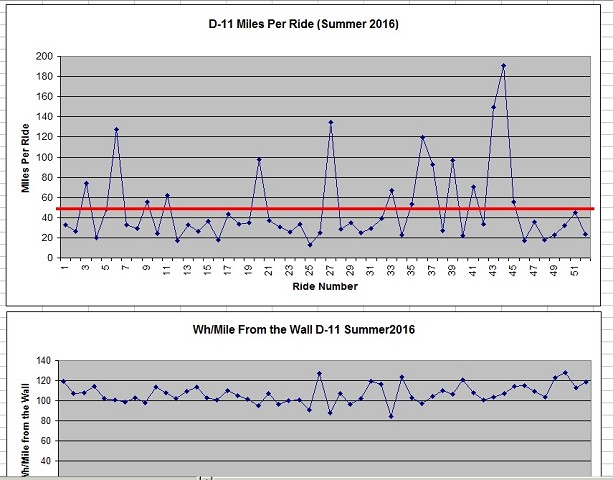 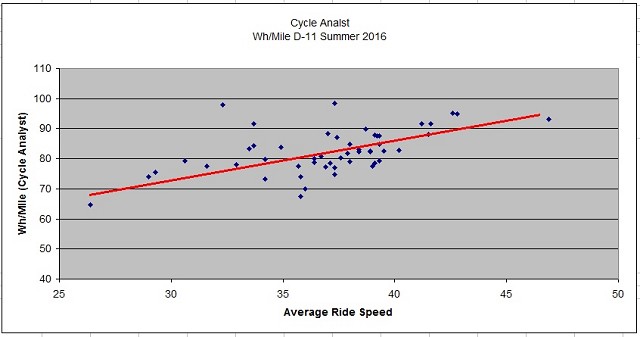 The average speed is an interesting metric. It always surprises me how hard it is to have a high average speed on a commute. My commutes and even my Sunday morning rides nearly always take me into city riding which dramatically lowers the average speed, by stopping at traffic lights, riding at slower speeds, etc. This season, I pretty much rode the speed of traffic. When on long trips when no one was around I would ride 45mph. 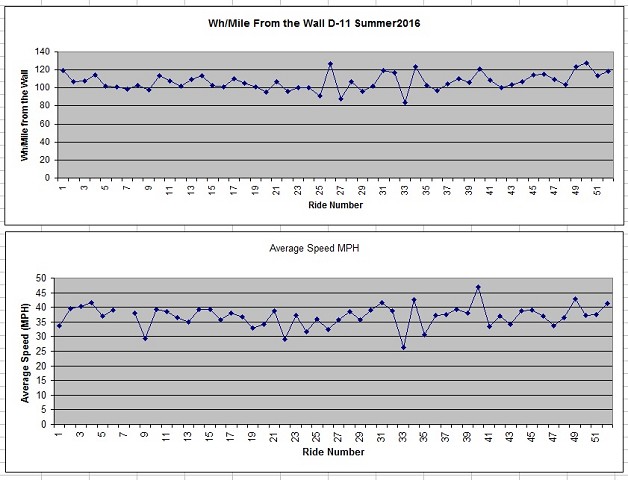 I began preping the Delta-11 in June. I planned to keep my Chevy volt batteries in electric car and put the original Enginer Lithium Iron Phospate batteries back in the D-11. and carry one Chevy Volt pack on the back of the bike and/or have all three packs available for swapping out during the Vetter Challenge. Here is the bike going back to together with the original pack from 2011. 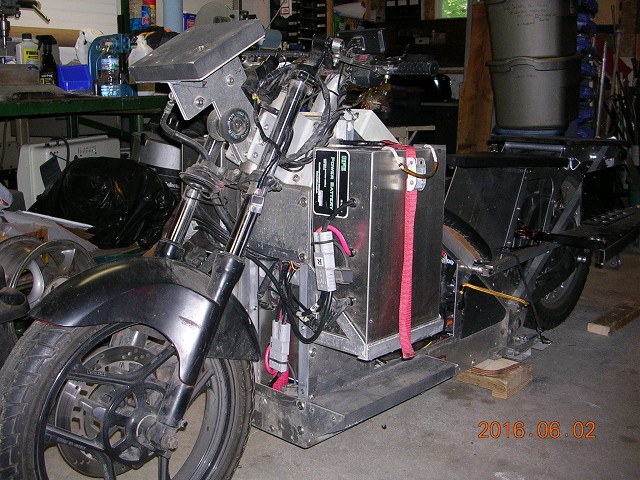 Since the orginal pack weighed 200# and I'd be carrying another 100#, 4.5kW portion of a Chevy Volt pack on the tail, I wanted to upgrade my suspension. I want an adjustable height that can be adjusted easily during riding so that ground clearance is correct and the center stand works correctly. Here are some of the shocks I experiemented with. None of them worked. (note: I did get another one that I haven't tried yet at the VMD Swap Meet in July 2016).  I paid $80 for a new set of Monroe air shocks from a 1970's Corvette. Harley Davidson riders claimed it had given their bikes adjustable ride height. One shock was not enough to support the D-11, so I went back to using a Yamaha Road Star Monoshock. 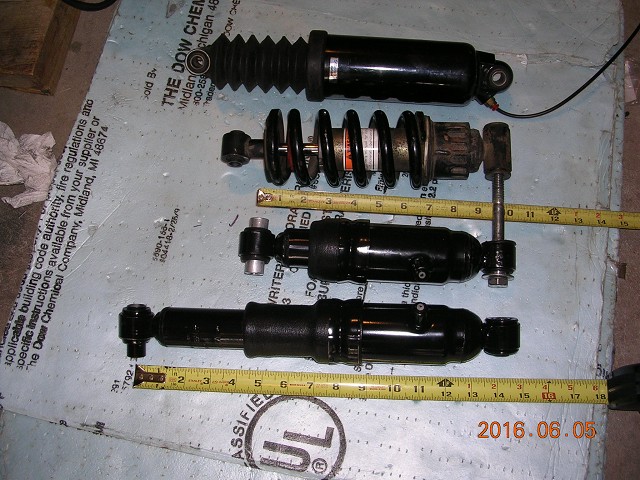 Here is the first ride of the season, June 23 and wouldn't you know it, I got caught in the rain! But, it wasn't a bad omen, I only got caught in the rain on one other ride for the rest of the season. And by the way, the fairing keeps the rain at bay nicely, except for when I come to a stop, then I get drenched. There are two areas to improve. I need an inner bulkhead ahead of my toes to keep the water from the front wheel off my feet. Also, the transition area between the canopy and the fairing has foam that was cut to remove the canopy. This cut provides a place for water running up the lip under the canopy to run directly onto my forearms. I put a bit of tape on the seam and it stopped that action, so I need to put the tape on it whenever I put the canopy back on. 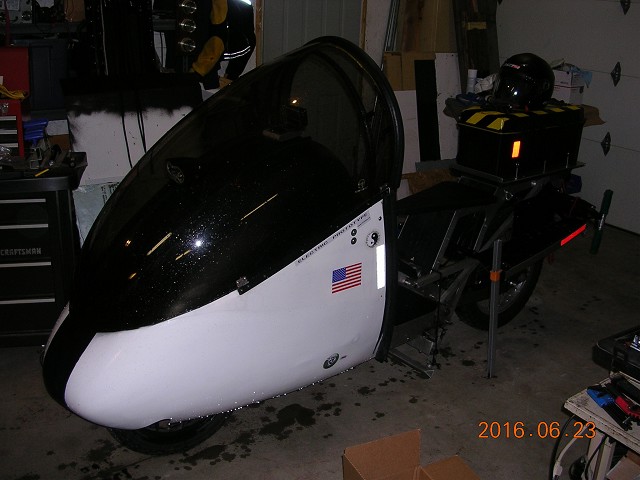 I blew up one of my best chargers by hooking it to 220V without flipping the switch to 220V first. So, I needed some more chargers. To save money, I found some 48VDC output industrial power supplies that cost $40 each and put them in AMMO boxes with some cooling fans I bought at yard sale. The "ammo box" chargers each put out 1,500 watts, can run on 120VAC or 220VAC and are relatively water resistant and robust to physical harm. By putting the power supplies in parallel and series I'm able to charge the batteries to 112V. 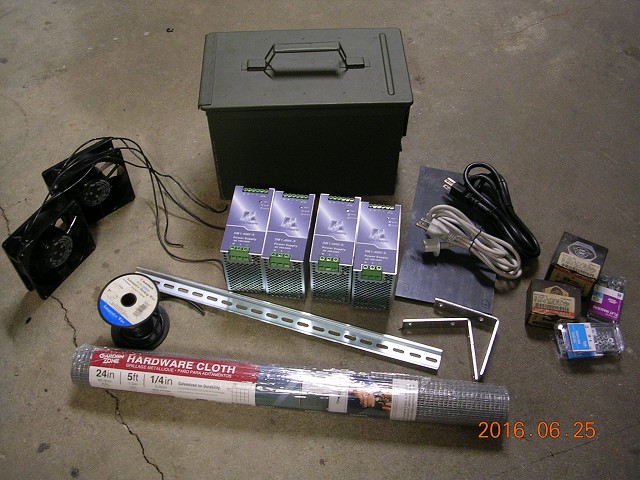 After some test rides with 300# of batteries, I decided that wasn't going to work. The original batteries did not have the capacity to weight ratio of the Chevy Volt batteries. So, I decided to install the Chevy Volt pack back inside the frame for a second riding season. 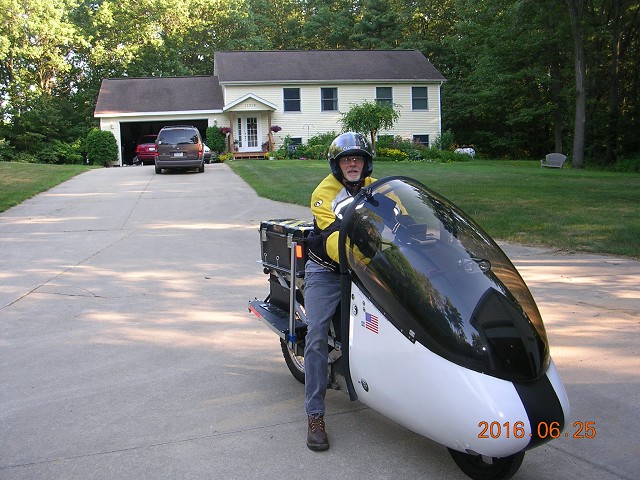 Here's the dashboard before the swap. 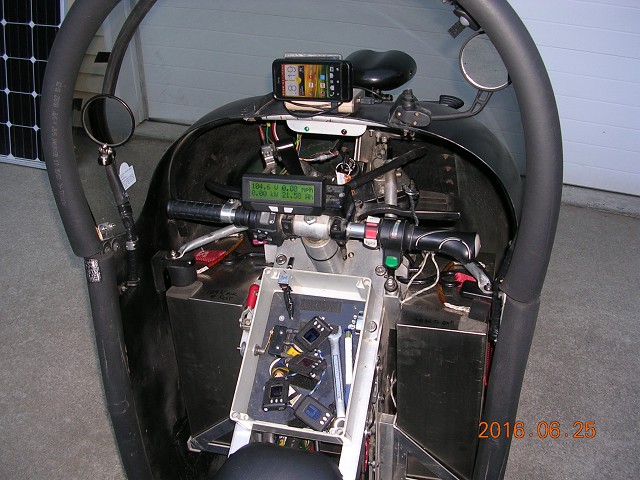 Battery swap in process. 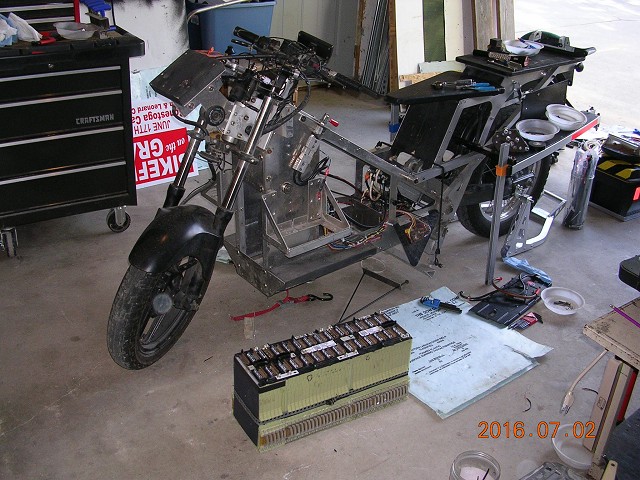 The cooling fins were a pain in the butt due to tight clearances, so I decided to cut them off. Performance wasn't hurt that can tell, I've programmed my controller to draw 16kW maximum, so the batteries are never under great load. Each pack is 4.5kW so at 16kW peak, that is only 3.5C. The hub motor is the limiting factor, it would need some extra cooling before the batteries would. I've ridden several 10 miles legs of trips at 65-70 mph and so far nothing has overheated. 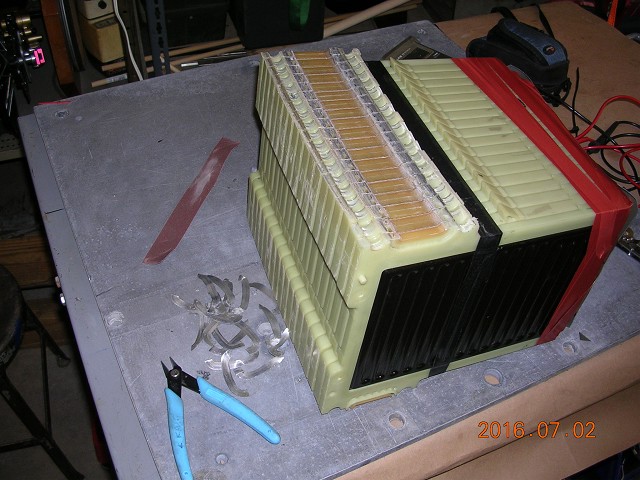 Added a lever arm to switch the golf cart reversing switch that switches between the front battery and the battery on the back of the bike. 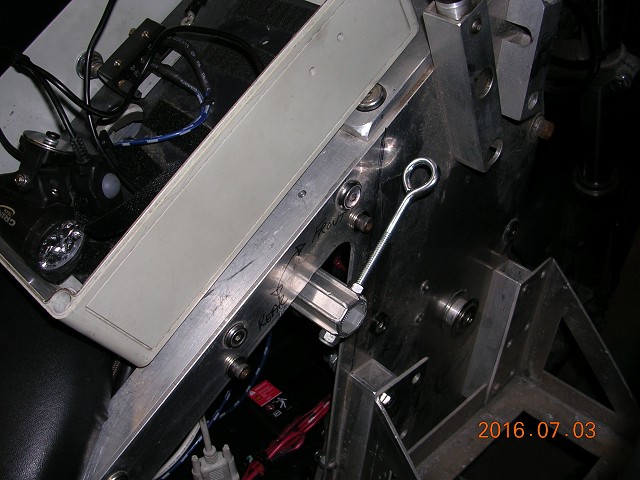 Done with the swap, ready for bodywork to go back on. 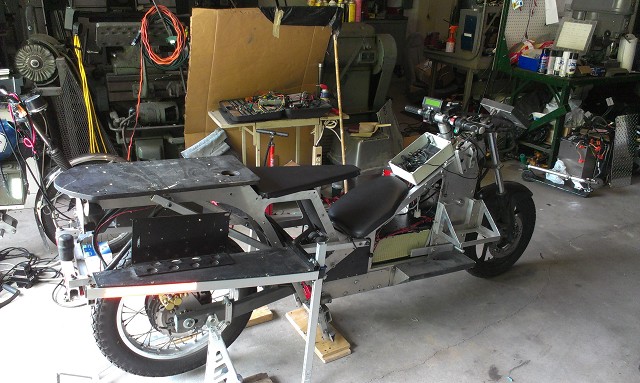 Ready to ride with the extra battery pack on the back of the bike. 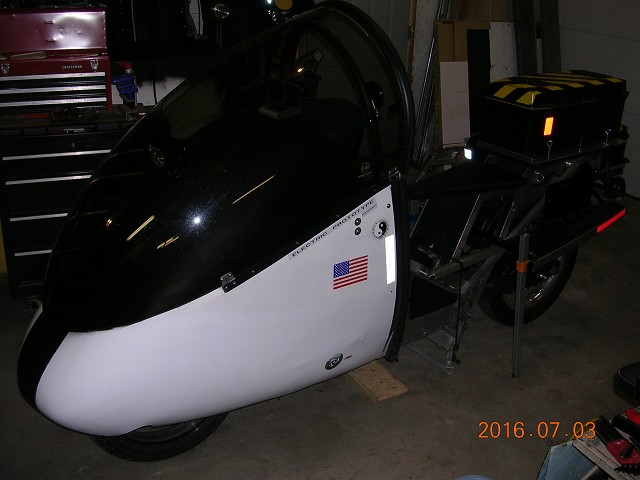 Here's a picture I took of Craig Vetter in July 2015 sitting in front of his original streamliner from the 1980's while he told me the story about how it started out the "only proper color for a streamliner (silver)" and got painted blue after being broken in two in a crash. 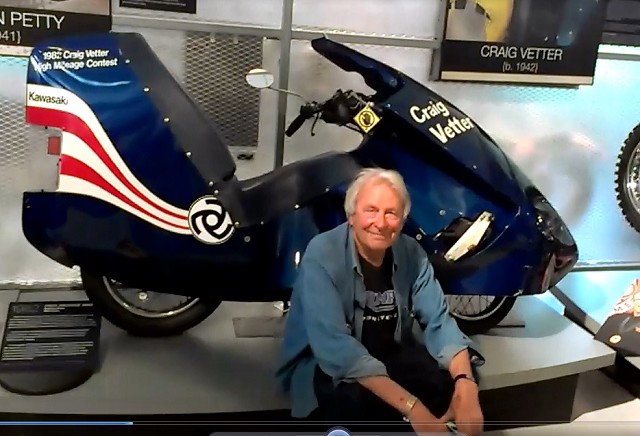 In August 2015, Craig Vetter was hit by a deer while riding his streamliner and the resulting injuries led to severe complications. Here are pictures of his streamliner after he was evactuated to the ER. To stay focused on his recovery, Craig did not plan to attend the 2016 Vintage Motorcycle Days event. So, in February, I along with several of the people who've been doing the challenge rides each year volunteered to help coordinate the 2016 Mid-Ohio Vetter Challenge. 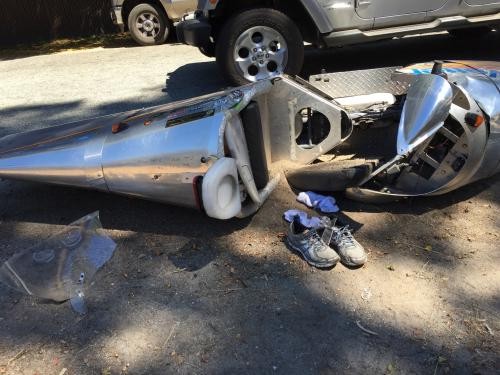 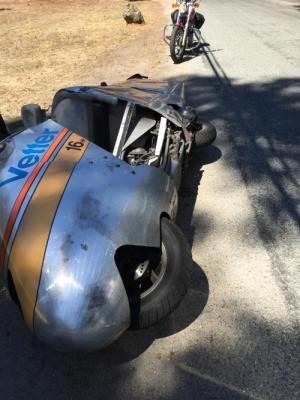 My boys helped me with logistics for the Vetter Challenge in Ohio 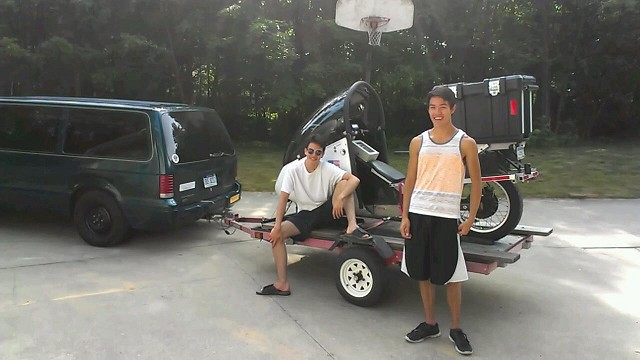 Here we are getting some food during the trip  Vetter Challenge Ride in Ohio. I was the pace vehicle for the 14 motorcycles that rode in this event. See details of the 2016 Mid-Ohio Vetter Challenge Click Here 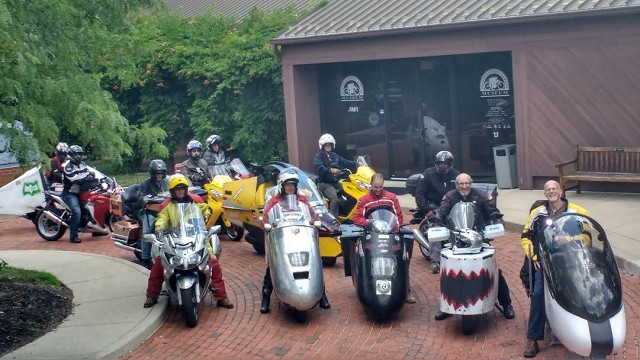 For details of the weekend including Vintage Motorcycle Days Talk and Swap Meet Click Here 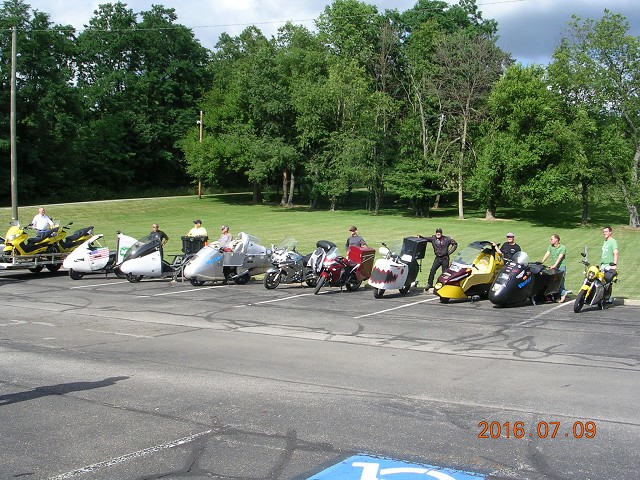 Here is a special pig tail I made up on the weekend at Vintage Motorcycle Days. It is an RV50 plug with four, 120VAC outputs and six, 220VAC outputs. 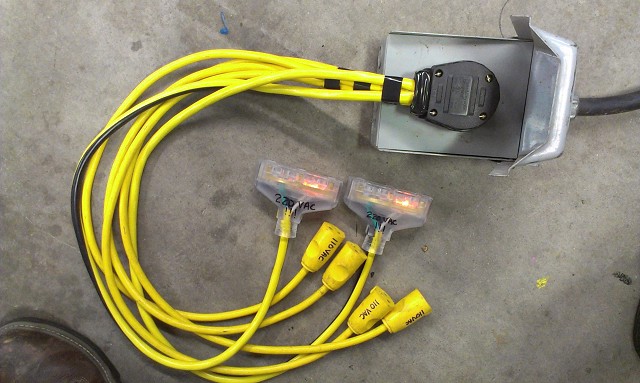 Here are three electric motorcycles being charged from one RV50 outlet! 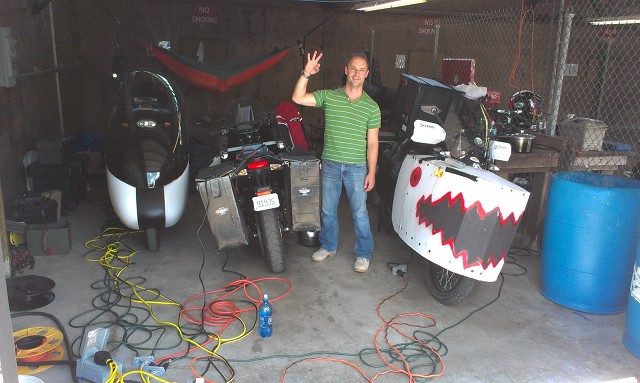 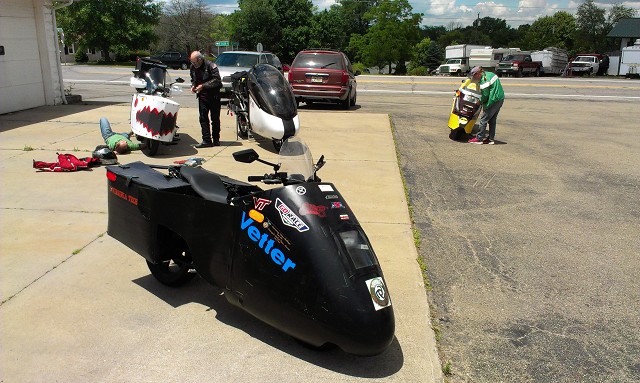 The Vetter Challenge was so close this year, it took two weeks to finally determine who won, gas or electric. The most efficient gas bike and electric bike are shown below. 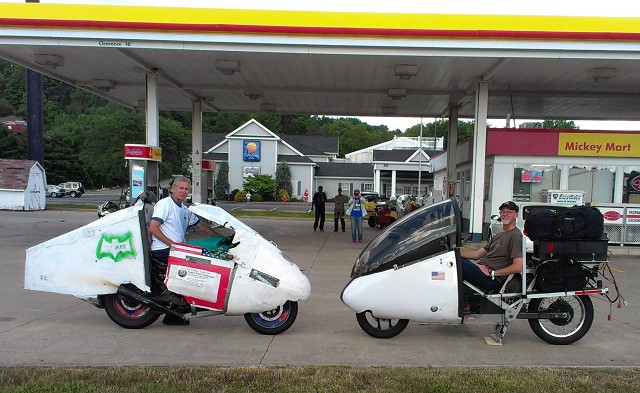  The racks orginally designed to hold battery packs work great for holding some modified plastic trash bins for hauling extra gear. Could carry jugs milk, extra charging gear, water bottles, snacks. When going through a drive through, just toss the food into the open storage and ride off. 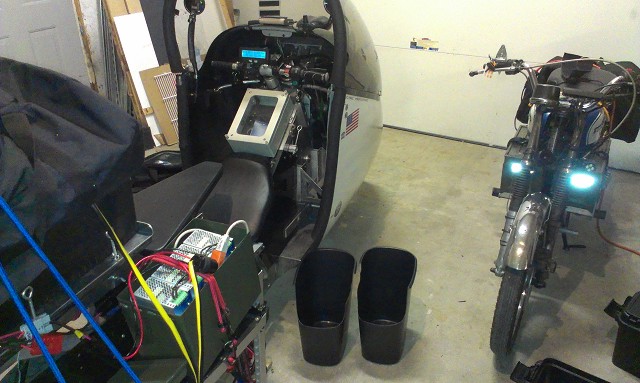 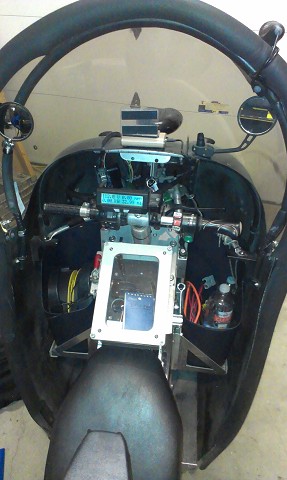 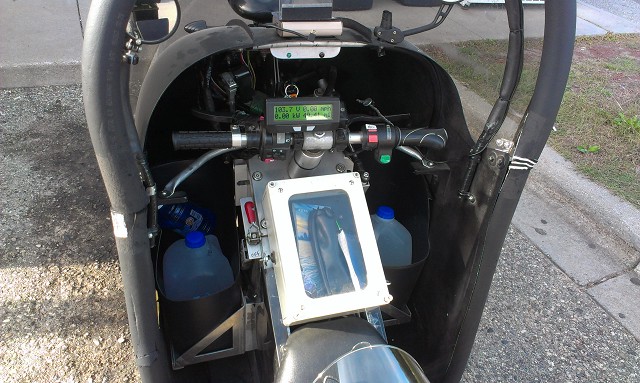 Sunday joy ride (July 31), charging in Rockford from an RV50 outlet. 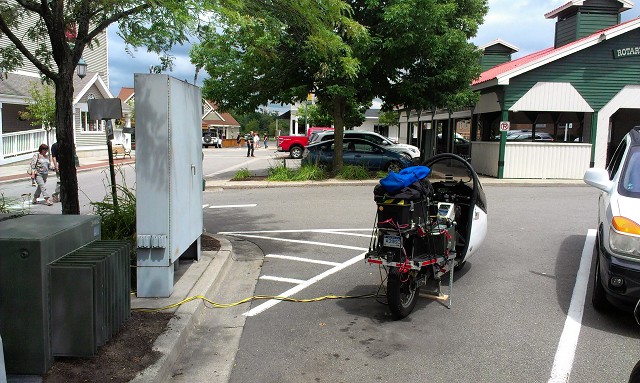 Sunday joy ride (August 7), eating at a cafe in Hart overlooking the water while re-charging at a nearby Chargepoint. There is also a lower cost place to eat in the back of a nearby Mexican grocery store.  Catching a quick top up at the Nissan dealer in Norton Shores. I walked over and did some grocery shopping at Meijers. 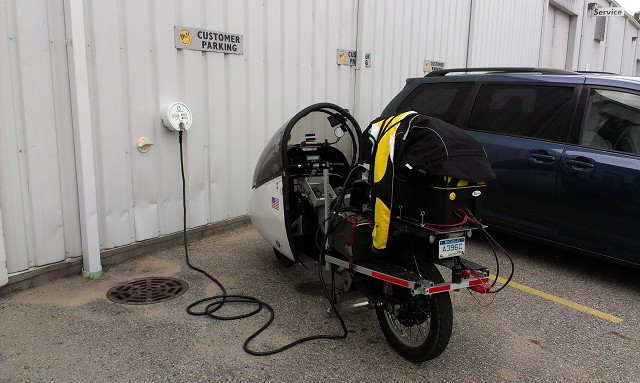 Holy Lack of ground clearance! On each side is a charger in a 50 Cal. ammo box, the FatMax toolbox holds 100# of batteries, on top of the toolbox is a bag holding another two chargers, several extension cords, RV50 Pigtail, J1772 pigtail and on the very top my Razer Scooter in a blue bag. 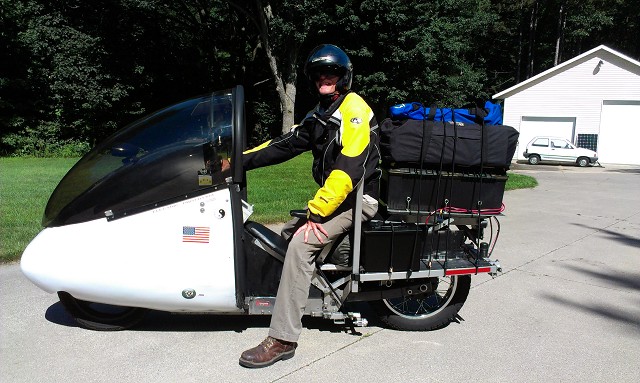 Sunday joy ride (August 28), recharging at the Holland Farmers market. I started using the cover to secure the bike when charging and to make it less obvious when I'm not around. I rode off on my Razor scooter and found a place to eat lunch. 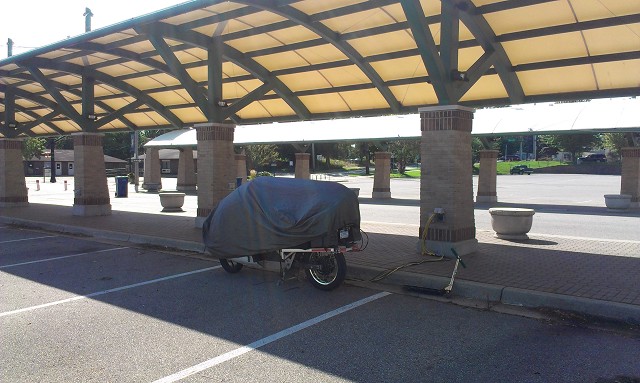 Sunday Joy Ride (Sept. 9), Secured for charging at the Pere Marquette Chargepoint. I went swimming in Lake Michigan and had some lunch. 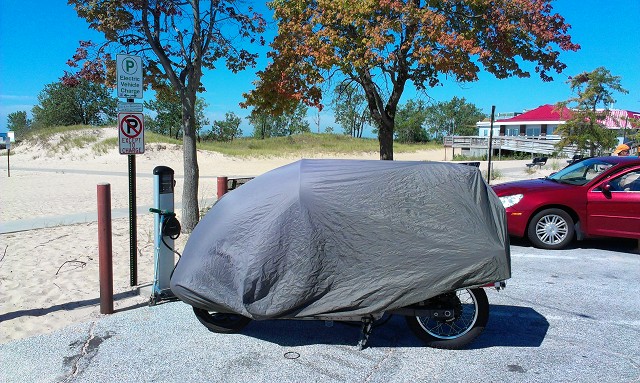 Then I went for a tour of the Milwaukee Clipper, something I've wanted to do all my life! The Clipper has parked in Muskegon for my entire Childhood, and finally I got to go on-board. The tour was well worth the money. 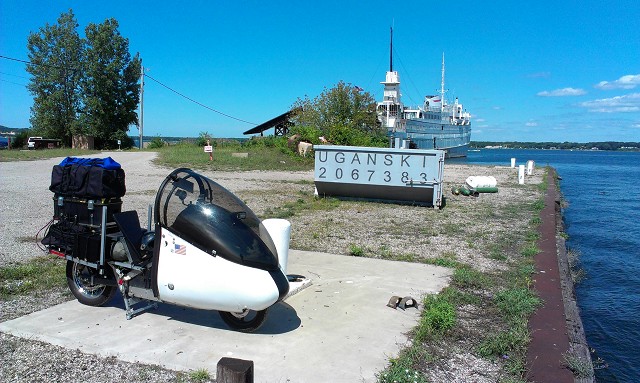 My son Nick and I did a few joint rides together. His CB-125S conversion is geared for a top speed of 35mph right now. We rode to Holland and Grand Haven together several times. The little Honda and the D-11 get the same efficiency at 30mph: 55Wh/Mile. When we get into city traffic at Moped speeds the D-11 efficiency drops to 66Wh/Mile. So, for tooling around in the city, it's more efficient to have a lightweight open bike, like an electric moped. 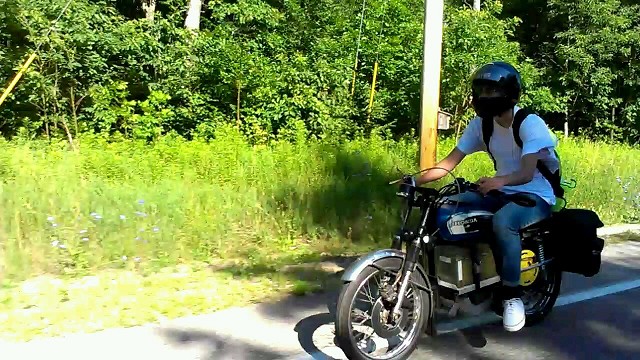 Nick won't wear all the gear I want him to. I require a helmut and light colored clothing. I highly recommend Jacket, gloves, boots, etc. But, he's young and hopefully will pay attention to what his dad does eventually. Note: He crashed at the end of our driveway on gravel pretty good later in the season and got some gravel in his hands - his helmet took a good hit to. He said he's wearing long pants and gloves from now on and is really glad he was wearing a helmet. The ride was just a quick 1 mile jaunt down the road to the neighbors and back - you never can tell when safety gear will save your "butt". 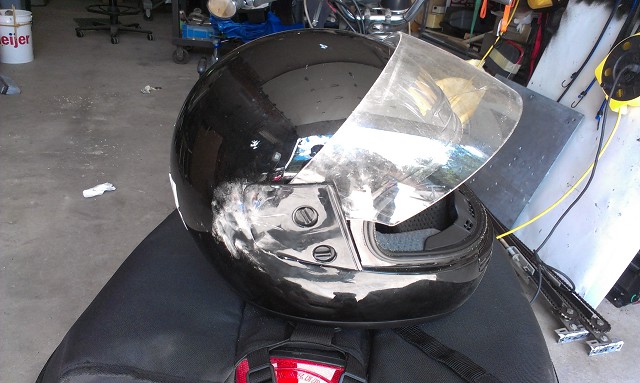 CAN"T RELY ON PUBLIC CHARGING: Once to Holland, we headed to the first Chargepoint location, it had a gas car parked in the spot. The second chargepoint was out of order. The third chargepoint had a Nissan Leaf on charge at Level 2. So, we put Nicks bike on Level 1 charge, as a result Nick was late for his date. 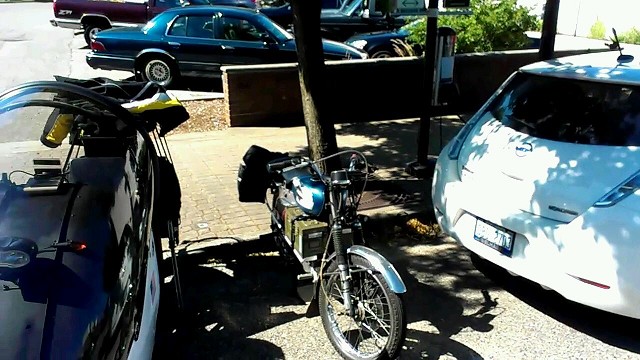 Sunday Joy Ride (Sept. 11). Rode down to Holland with my son Nick. We had lunch and he found some friends and rode home separately. This time we charged at the Holland Farmers market where there are over ten, RV50 outlets. 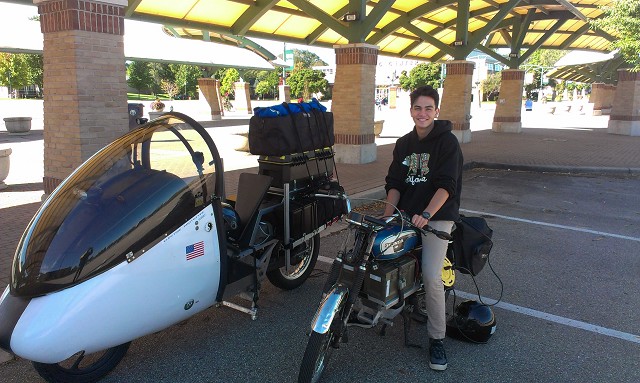 Tony Helmholdt (Sept 11) on his Zero DS met me in Holland and we rode up the coast visiting all the parks on the way. He caught a charge in Grand Haven while we got some food. 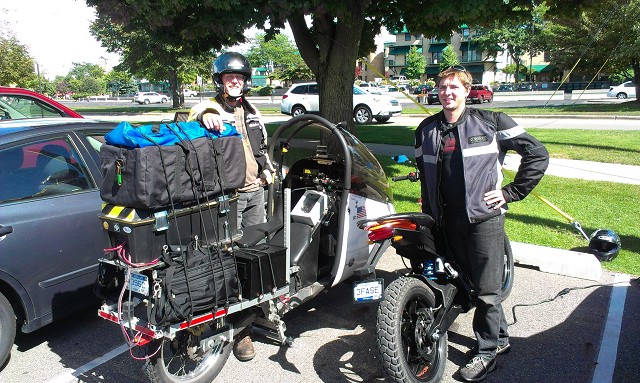 Sept. 13-14 I rode down to Novi and back for The Battery Show. This is the first charging stop at Lowell, MI. Charged in Lowell going and returning. Really like that Chargepoint station by the showboat, and library. It's just across the street from a great restaurant (The Flat River Grill). I love that the Chargepoint app. keeps me posted on my charge status so I can relax and enjoy eating a relaxing meal in the outdoor seating section There are RV30 and RV50 outlets near the showboat, I figure we could recharge 5-7 electric bikes if we did a ride through there. This is the bike as gear was arranged when it was being ridden on this ride 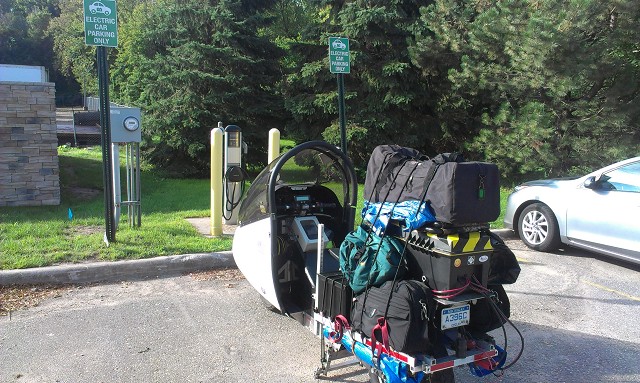 With all my camping and charging gear on the bike, it starts looking like the truck from the Beverly Hillbillies. I was expecting rain and so had extra blue tarps hanging out. The odd ball colors of gear makes it look worse. I received much fewer positive comments on the bike and lots less interruptions from curious people. I've noticed that people don't bug me when it looks like crap, but when it's all looking good, people flock around at every stop wanting to know what it is, what is range, how long to charge, how fast does it go? Looks like a science experiment gone wrong? I have 4 chargers running pulling 5 kW from the Chargepoint station. 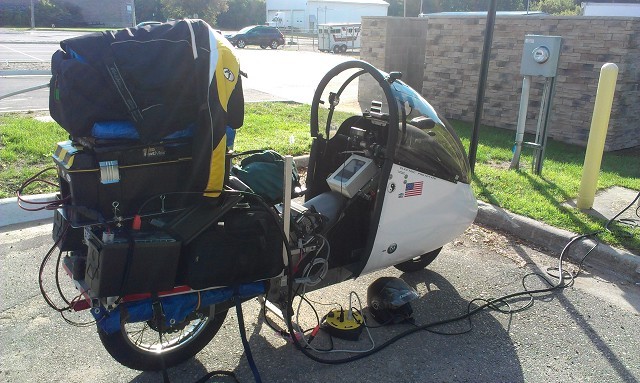 Note that I found some good locations for storing gear that made the weight distribution almost perfect. I put my tent and razor scooter opposite each other UNDERNEATH the rear cargo racks. I put my extension cords, RV50 and J1772 breakouts in the front storage by my feet, the green bag was my day pack with snacks, rain gear, etc. One of my black laptop bags held all my clothing. The other black laptop bag held my camping gear including my sleeping bag. The top duffule bag held two 1,000 Watt chargers, two more extension cords, and a transformer to run my 220V cooling fans. The 50 Cal. ammo boxes each held a 1500 Watt Charger.  To hide the tangle of wires I have started to cover my bike when charging in public. The next bike I build will address this issue by making on-board charging painless and pretty. 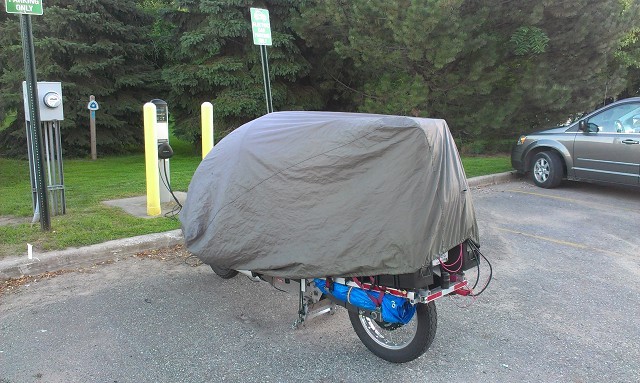 Second charging stop in Lansing - I got ICE'ed by a Prius and a Chevy Volt. To be ICE'd is to need public charging, but have access blocked by an ICE (Internal Combustion Engine) powered vehicle parking in the parking spot. So, I had to move to a different charging location. 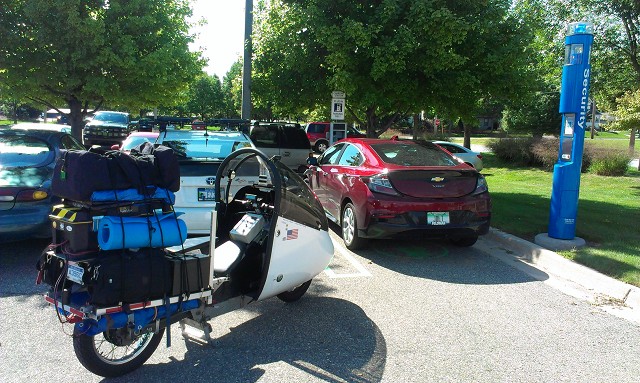 Here is where I ended up charging in Lansing both going and coming back. It's the Lansing City Market. They have nice selection of places to eat inside along with locally grown food. I walked and rode razor scooter to several museums from here. Learned that REO car company was started by Ransom E Olds after he left Oldsmobile, which he also started. Rode to Lansing to charge at the Lansing City Market (charged there going and coming back). On Tuesday, I ate lunch and visited the Lansing Historical Museum. On Wednesday, I searched local parks for charging infrastructure, and visited the Ransom E. Olds Museum while charging. 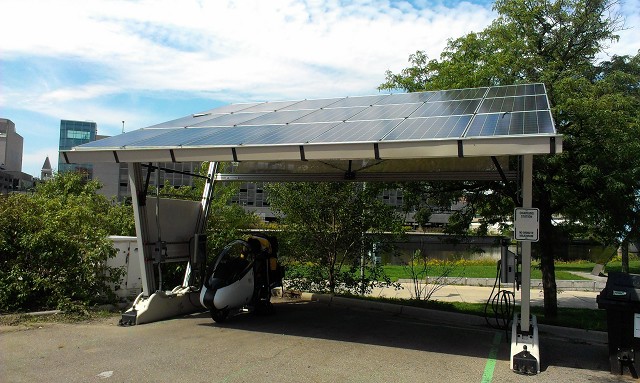 Here's my campsite the first night at Camp Dearborn, all to myself. Went for a swim in the lake. 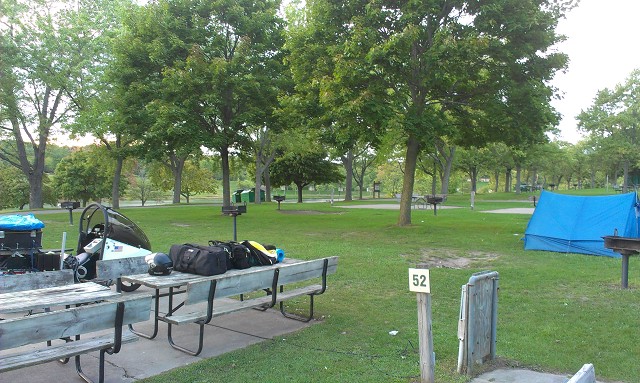 After leaving the Battery Show, I rode out to Tanger Outlet Mall (Howell) to charge while eating lunch. While at Tanger found four, RV50 outlets there that I added to Plugshare. This picture shows the courtyard with RV50 outlets right on the edge of the parking lot. On way down (on Tuesday) I rode on Grand River Ave. from Lowell all the way to near Camp Dearborn. There were lots of bumpy seams in the road so on the way back I headed straight north out of Lansing to get into beautiful rolling farmland that looks a lot like the farmland north of Grand Rapids. M21 is an excellent winding 2 lane highway east of Lowell. I'll definitely do some trips straight east out of Lowell in the future on M21. 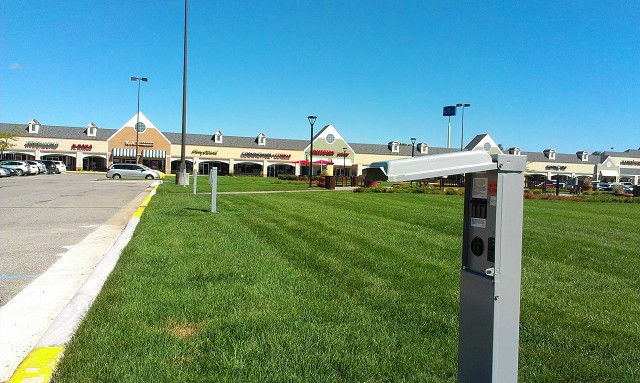 The ride back from the Battery Show was a new, one day personal record for me 190 miles. I started the day from Camp Dearborn where I had camped for the night, rode into Novi for the Show, charged up while meeting some new and old friends at the show, then rode to Tanger Outlets in Howell for lunch, Lansing for some Museums, Lowell for Dinner and then home. 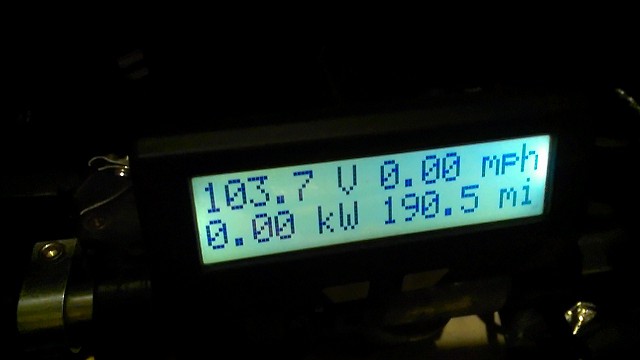 I carried lots of cargo on my bike this season. One day, I used my trailer so I could take a large trailer tire to the tire store to get the valve stem replaced. 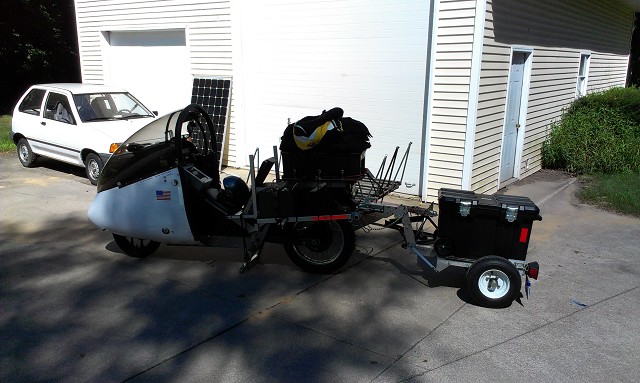 On another day, I found a chop saw at a garage sale for $25. Since, I've always wanted one, I strapped it on top and carefully rode home - luckily, it was all straight roads and only 10 miles. 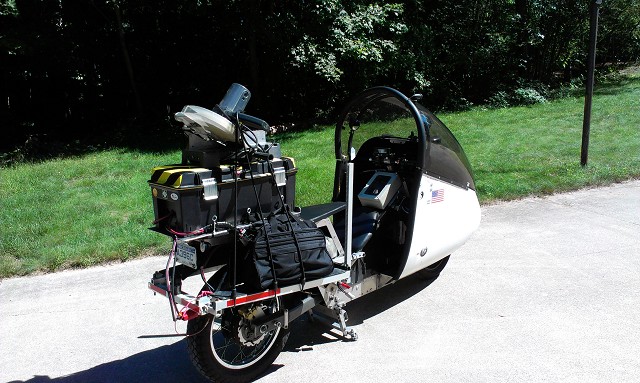 I scoutied out many new charging locations in West Michigan. I'm hoping to one day lead an electric vehicle rally where we drive from town to town. I've collected quite a list of great locations to stop where we can quickly charge 5 or more electric vehicles at a time (i.e. RV50 outlets). Pere Marquette Park in Muskegon is one of those locations. There is a Chargepoint, some RV50's, and quite a few 20A 110's. 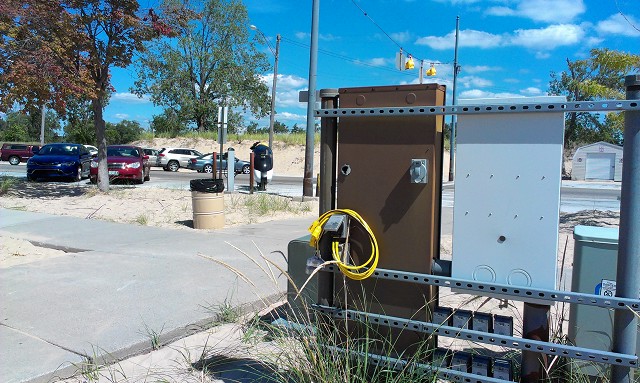 The battery's were moved from the D-11 motorcycle to the 1990 Ford Festiva Electric over the first weekend in October. The lifetime fuel economy of each electric vehicle is shown in the picture. Festiva: 120MPGe D-11: 350 MPGe 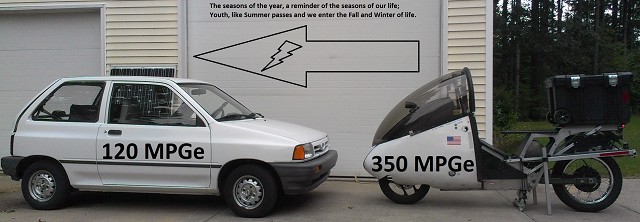 When I'm moving the batteries from vehicle to vehicle it's a perfect opportunity to check and adjust the balance of the cells. I do this with timers and a power supply and car headlights. By loading or charging individual or groups of cells I can quickly get them to all read within .01 volts. Because I don't over charge or discharge, the Chevy volt cells stay balanced very nicely, and only need balancing every 5,000 to 10,000 miles. 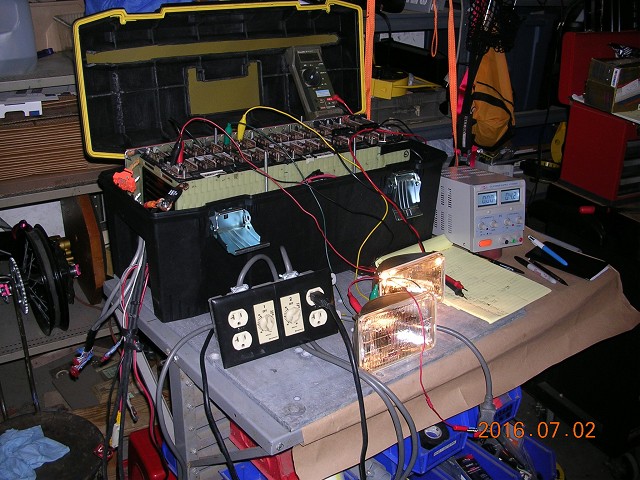 I have sometimes got a lot of electric miles on my motorcycle in October. But, this year I switched the batteries to the Festiva on October 1st. I'm glad, as we've had lots of rainy weather so far in October and I've enjoyed the silent, dry comfort of my little electric car. 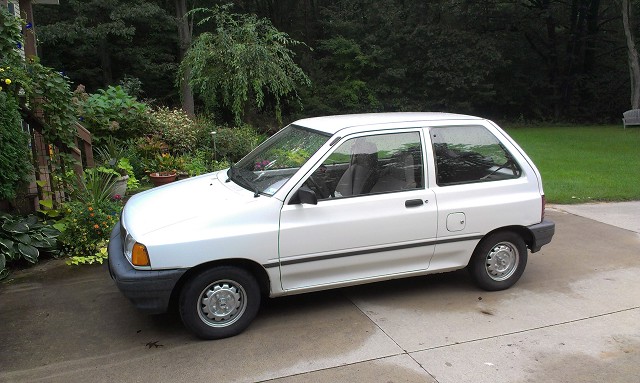 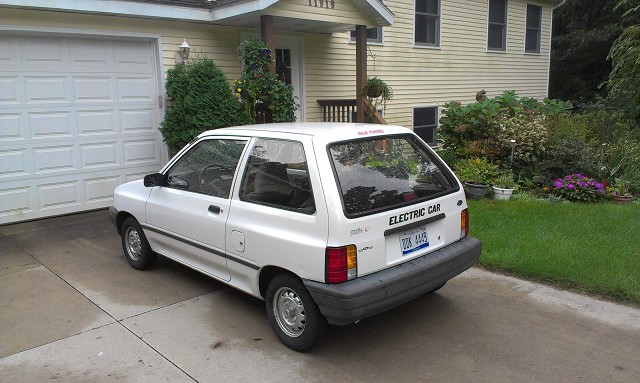 Here are the battery packs snuggled it the back of the Festiva under a green blanket. The black boxes on top are for carrying groceries. 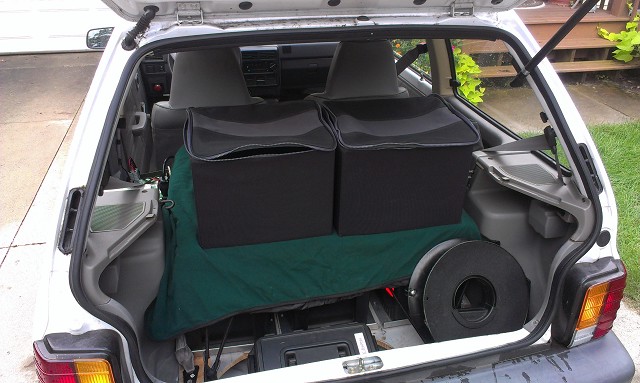 October 8th, 2016 I've been discouraged this year to have come so close to having Bernie as our president and then fallen to a choice between a pro-establishment (more of the same) candidate and a buffoon. I took stock the other day and wrote myself a note, yes, things are not going so great in 2016, but, that does not need to stop me from making progress. I listed specific actions I can take. Here they are.  Positive Things I can work on: Update my website with what I learned this year Move my solar panels from behind the house to the front of the barn for better sun exposure Clean up my house and work shop Get my own financial house in order – pay off my debt Put up more solar panels Drive more gas free miles Design and build electric streamlined vehicles that people want and will purchase Install a wood furnace and trim some trees back so they don't fall on my workshop and block my solar Get my V2G Vehicle to Grid system working Get prepared for the fall of civilization |
|
(Next Page) |
|
Inventing a better tomorrow today... Copyright 2016, Schultz Engineering, LLC, written by Kraig Schultz |